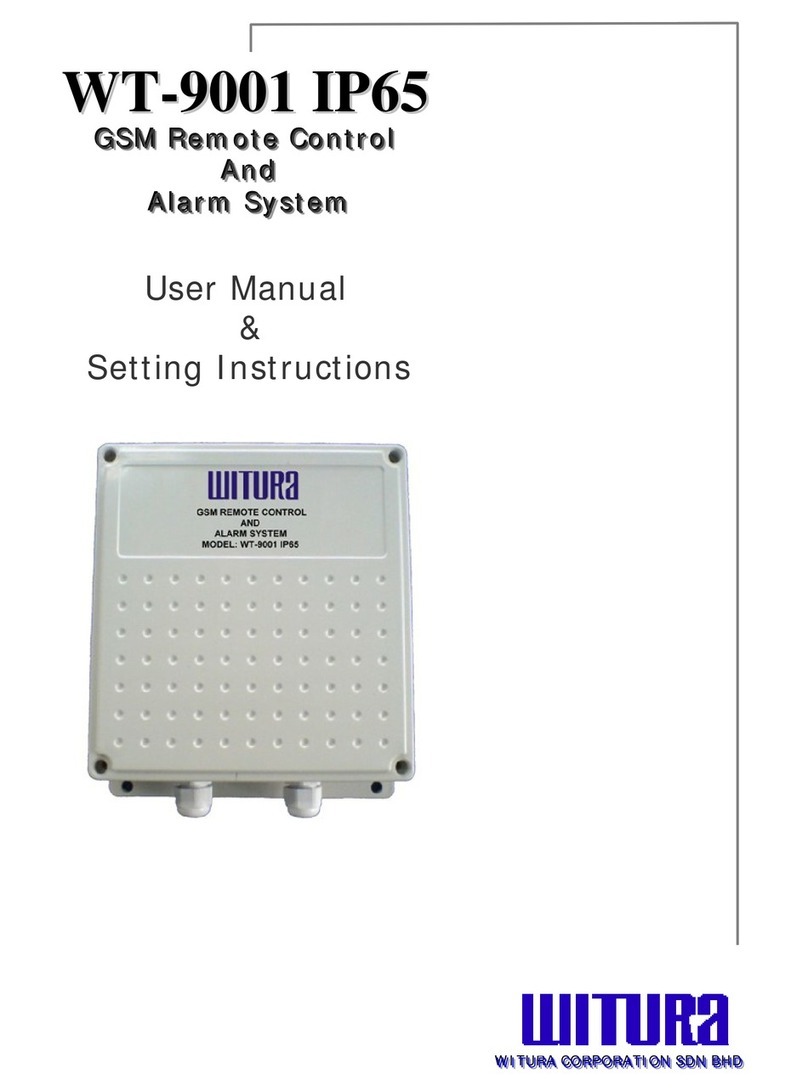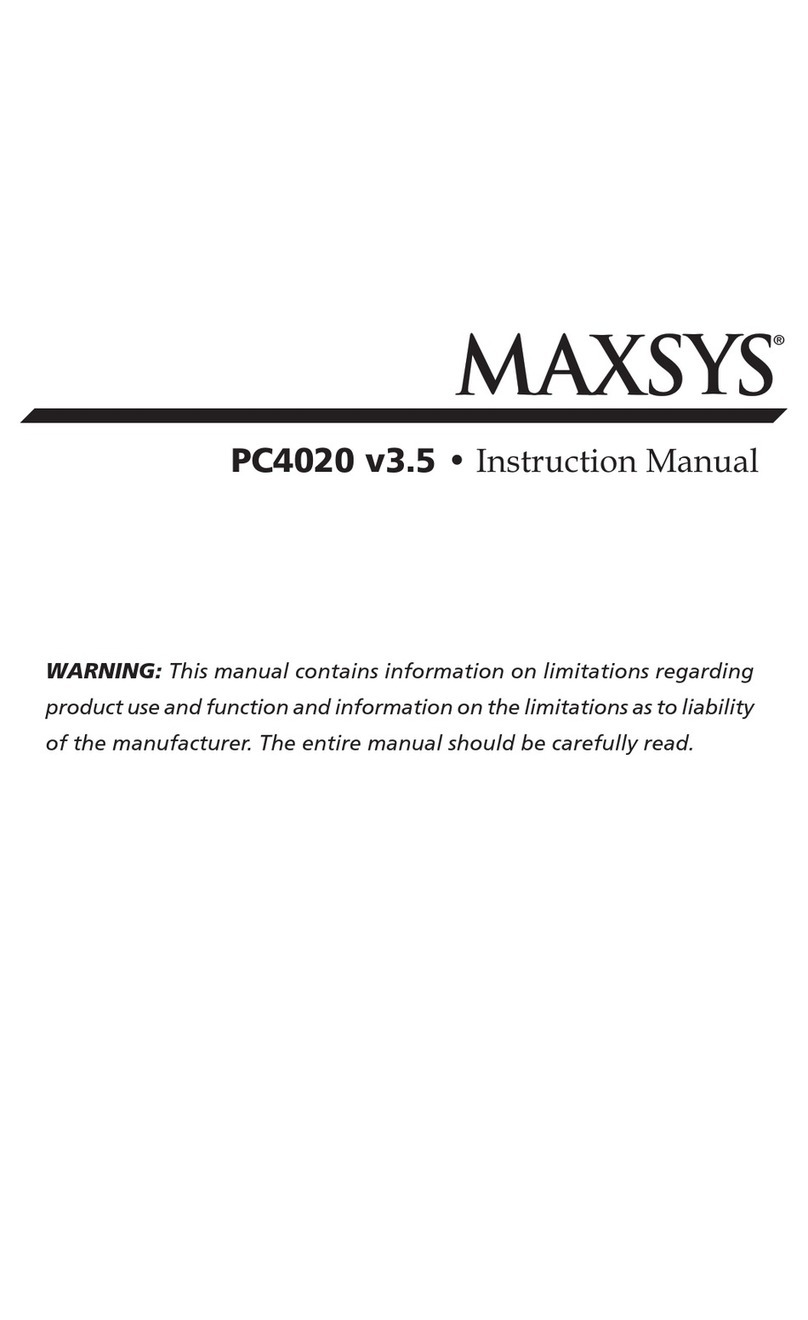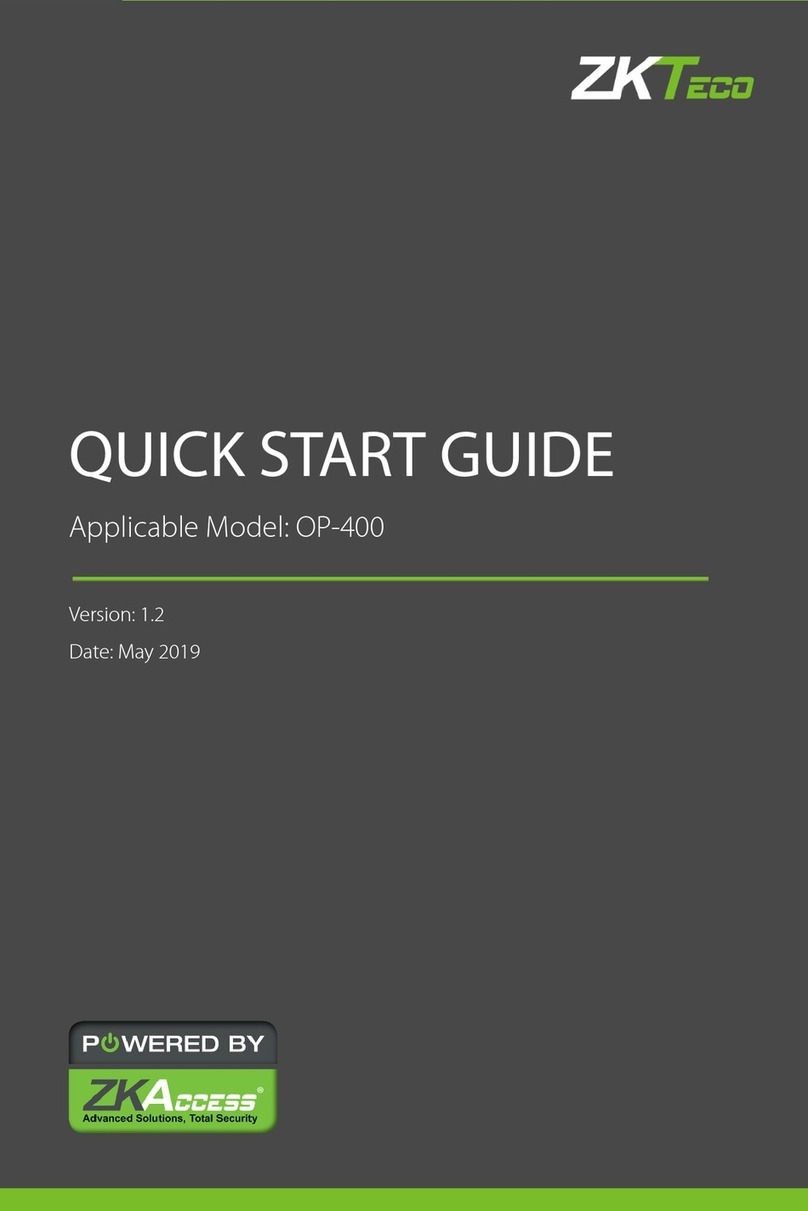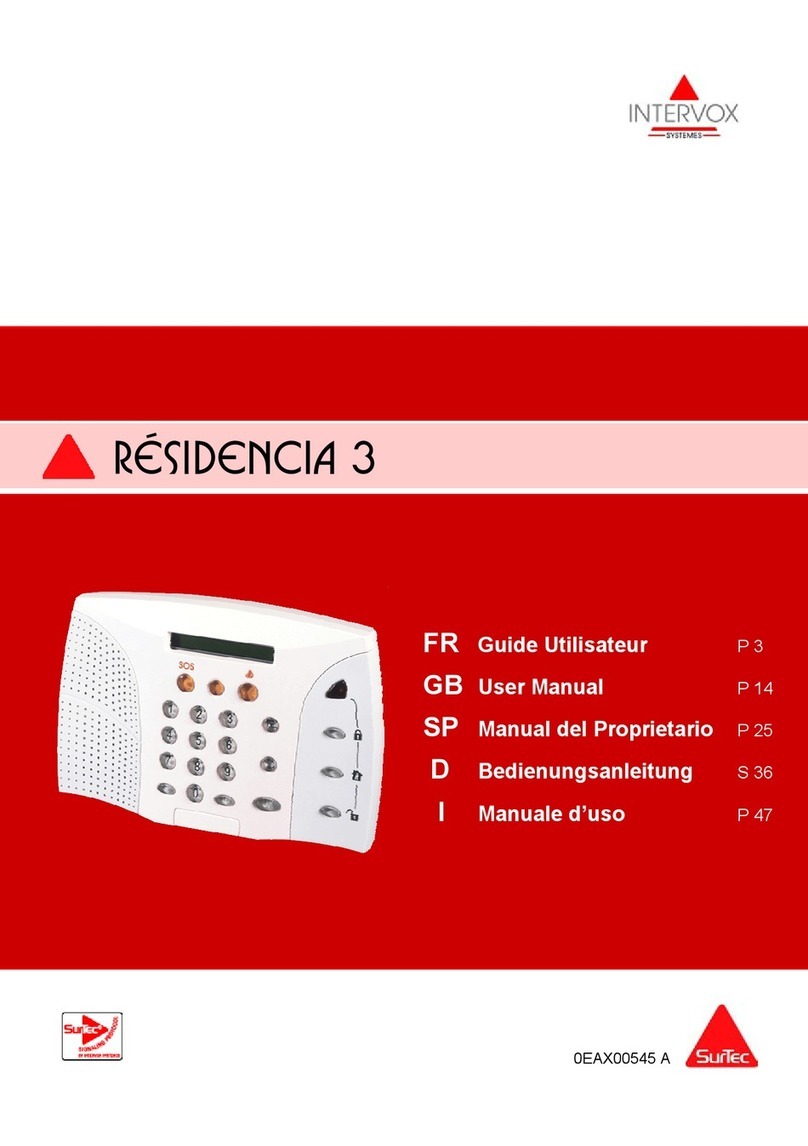MGP WRM2 User manual

OPERATING MANUAL
WRM2
Wireless Remote Monitoring System 2
Document # 15-00043
Revision 3
September 2005

15-00043
Revision 3
September 2005
The publication, translation or reproduction, either party or wholly, of this document are not allowed without our written consent. 2
Revision Log
Revision #
Date
Revised
Pages
Comments
0
1
2
3
07/31/2004
12/29/04
6/2005
9/2005
N/A
ALL
ALL
13-14
26
ALL
Original issue.
Added comments from KS/JK
- Update, add Images
- Modify Section 2.2.3, Radio Mode Selector
positions and description
- Minor reformatting
- Add Appendix 2: Alternate network Adapter
Programming
Section 2.2.3 Radio & Network Adapter Configuration:
- Modify Table 2 for description of Communication
Mode Summary
- Modify Figure 4 – Front Panel
Changes made to reflect actual operation of rotary
switch mode positions and description for WRM2 Base
Transceiver
Modify Table 3 to include baud rate settings for
devices connected to the WRM2 External Transceiver
General edits

15-00043
Revision 3
September 2005
The publication, translation or reproduction, either party or wholly, of this document are not allowed without our written consent. 3
WRM-2 FCC COMPLIANCE
ANTENNA WARNING
FCC QUALIFICATIONS
Important: The WR2 radio modules have been certified by the FCC for integration into OEM
products without any further certifications (as per FCC section 2.1091). Changes
not expressly approved by MGP Instruments could void the user’s authority to
operate this equipment.
This device complies with Part 15 of the FCC rules. Operation is
subject to the following conditions: (1) this device may not cause harmful interference
and (2) this device must accept any interference received, including interference that
may cause undesired operation
This device has been tested with Reverse Polarity SMA and MMCX
connectors with the antennas that are supplied with the equipment. When integrated
in the OEM product, these fixed antennas require installation preventing end users
from replacing them with non-approved antennas. Any antennas not supplied by
MGP Instruments must be tested to comply with FCC Section 15.203 for unique
antenna connectors and section 15 emissions.

15-00043
Revision 3
September 2005
The publication, translation or reproduction, either party or wholly, of this document are not allowed without our written consent. 4
Table of Contents
1.0 Introduction ..................................................................................................................................................5
2.0 Equipment Description & Operation ............................................................................................................6
2.1 PAM-TRX (Personal Alarm Module Transmitter).....................................................................6
2.1 PAM-TRX (Personal Alarm Module Transmitter).....................................................................6
2.1.1 Features:.....................................................................................................................6
2.1.2 Operation.....................................................................................................................7
2.1.3 DIP Switch Settings.....................................................................................................9
2.1.4 Connecting to External Alarm Device.........................................................................9
2.1.5 Operational Test........................................................................................................10
2.1.6 Usage........................................................................................................................10
2.1.7 Battery Replacement ...............................................................................................10
2.2 WRM2 BASE TRANSCEIVER...............................................................................................11
2.2.1 Features:...................................................................................................................11
2.2.2 Operation...................................................................................................................12
2.2.3 Radio and network adaptor configuration.................................................................14
2.2.4 Batteries....................................................................................................................19
2.2.5 Operational Test........................................................................................................20
2.2.6 Usage........................................................................................................................20
2.3 WRM-2 REPEATER...............................................................................................................21
2.3.1 Features:...................................................................................................................21
2.3.2 Operation...................................................................................................................22
2.3.3 Settings......................................................................................................................22
2.3.4 Operational Test........................................................................................................23
2.3.5 Usage........................................................................................................................23
2.3.6 Battery.......................................................................................................................23
2.4 WRM-2 EXT – External Transceiver......................................................................................24
2.4.1 Features ....................................................................................................................24
2.4.2 Operation.................................................................................................................255
2.4.3 Settings .....................................................................................................................26
2.4.4 Operational Test........................................................................................................27
2.4.5 Usage........................................................................................................................27
2.4.6 Battery.......................................................................................................................27
3.0 Technical Characteristics....................................................................................................................28
3.1 PAM TRX ...............................................................................................................................28
3.2 WRM2 Base Transceiver .......................................................................................................29
3.3 WRM2 Repeater.....................................................................................................................30
3.4 WRM2 EXT.............................................................................................................................31
4.0 Recommended Spare Parts List................................................................................................................32
4.1 PAM-TRX Transceiver ...........................................................................................................32
4.2 WRM-2 Base..........................................................................................................................32
4.3 WRM-2 Repeater and External Transmitter...........................................................................33
APPENDIX 1: Dosimeter Data Protocol...........................................................................................................34
APPENDIX 2: Alternate Network Adapter Programming.................................................................................36

15-00043
Revision 3
September 2005
The publication, translation or reproduction, either party or wholly, of this document are not allowed without our written consent. 5
1.0 Introduction
The WRM2 telemetry system incorporates the features of multiple personnel devices into an integrated
package. The WRM2 telemetry system components include: Compact Transmitter, Base Transceiver,
Repeater and External Transceiver.
The WRM2 Compact Transmitter, named “PAM-TRX”, (Personal Alarm Module Transmitter) is a multi-
functioning transmitter for the DMC-2000 electronic dosimeter with enhanced alarm notifications and
options for various frequencies. Enhanced alarm notifications include directional audible speaker, dual
multicolor LED’s (top and face), vibration and external earphone/LED. Radio frequencies include
frequency hopping spread spectrum (FHSS) 900/868 MHz and 2.4 GHz. The PAM-TRX combines both
functions into one device but instead of using a custom 900 MHz transmitters, it uses a customized
commercial transceiver radio that can be selected in the 868, 900 or 2400 MHz band. All alarming
functions are user selectable similar to the PAM-TRX and all radio parameters including transmission
intervals are programmable via configuration software.
The Repeater and External Transceiver units are compact and easily deployable to further enhance the
wireless remote monitoring activities.
CAUTION: Only those power sources and power supplies as
recommended by MGPI should be used with all WRM2
components. Non-approved power sources can result in
component damage. Contact MGPI for additional information!

15-00043
Revision 3
September 2005
The publication, translation or reproduction, either party or wholly, of this document are not allowed without our written consent. 6
2.0 Equipment Description & Operation
2.1 PAM-TRX (Personal Alarm Module Transmitter)
2.1.1 Features:
•High volume buzzer, 85 dBA at 2200 ±500 Hz mounted on the
top of the enclosure facing the user
•Two high intensity multicolor LED’s. One facing the user on
top of the enclosure and one on the enclosure front to facilitate
monitoring by other workers in the vicinity of the user. The
LED indications: GREEN flash to indicate data transmission
and a good battery and, RED to indicate a local alarm triggered
by the dosimeter. An option configuration consists of a BLUE
flash to indicate the receive function is on, and data is being
received by the PAM-TRX (used for RF mapping applications).
•Driver and connector for external alarm devices: LED,
Earphone, EAM, etc.
•External DC supply capability.
•Single ‘AA’ Battery that can provide over 35 hours of
continuous operation with one hour of continuous alarming.
•Low battery indication
The PAM-TRX has a stereo jack to allow connection to the LED or earphone output, an 8 pin
connector to connect to a PC to allow radio programming and a power jack to allow connection of
an external power supply used to operate the alarms and the transmitter for area monitoring
applications.
The pattern of the audible and visible alarm signals are the same as the alarm signal from the
dosimeter - fast pulsating signals are integrated into a single alarm level to improve the
effectiveness of the vibration alarms. The PAM-TRX can be configured to latch the dose rate
alarm from the dosimeter.
CAUTION: If the optional alarm latch feature is enabled, once the latched alarm is
triggered, it is necessary to remove the battery to terminate the alarm condition.
Testing the alarm functions (red LED, vibrator and buzzer) is performed by pressing the test button
through the back of the enclosure. If the ILS feature is enabled, the alarm can be tested by placing
a magnet in proximity to the side of the enclosure.

15-00043
Revision 3
September 2005
The publication, translation or reproduction, either party or wholly, of this document are not allowed without our written consent. 7
Figure 1: PAM TRX Complete Assembly
NOTE: The PAM-TRX DOES NOT provide power to the dosimeter. Please contact
MGPI if the option is required for area monitoring applications where longer
dosimeter battery life is required.
2.1.2 Operation
Pushbutton
Display
Window
LED
Speaker
Port
Serial
Number ID
External
Powe
r
External Alarm
Accessory plug
Antenna
Pushbutton
Transmitter
(
under board
)
Speaker/LED
ISO Connector
Reed (ILS)
Switch
Battery
Com
p
artment Battery
Cove
r
Infrared
Ports (3)
View window for
Dosimeter S/N Rear Case
Cover
Clip
Test Button
access
DIP Switch
configuration
label
Slide
Switch
Battery
Cover
Screw

15-00043
Revision 3
September 2005
The publication, translation or reproduction, either party or wholly, of this document are not allowed without our written consent. 8
The PAM-TRX is designed to transmit the TTL RS-232 data packet from the dosimeter when the
DMC-2000 is configured with transmission ON, 4800 BAUD, Triggered. The unit is compatible
with all the DMC family gamma dosimeters data formats (DMC2000S, X and SOR/R).
Preparation for use:
2.1.2.1 To open the back case: remove the locking screw and slide off the battery cover. Remove
the battery (if installed) and then slide off the case back.
2.1.2.2 The dosimeter must be installed with the display towards the top window face down and
dosimeter clip removed. Once inserted, replace the back cover by sliding it up, ensuring
the dosimeter is properly seated and aligned with the ISO connector.
2.1.2.3 Ensure dipswitch settings are configured with all the desired options correctly selected.
See Section 2.1.3 for detailed configuration.
2.1.2.4 Install a new ‘AA’ 1.5 V alkaline battery. Replace the battery cover and secure with the
locking screw. Do not overtighten the locking screw. MGPI recommends using only
Duracell or Energizer brand batteries for best performance.
>> See Figure 1 for PAM-TRX part identification.
2.1.2.5 Turn the dosimeter ON. Note one single flash from the green led will indicate that the
battery, dosimeter and the radio are functioning properly. After one or two short alarm
cycles (while the low battery detector charges up), the PAM-TRX audibly chirp. At this
point, the green LED will flash at an interval defined by the radio configuration, typically
four (4) seconds. The radio is normally in a “sleep mode” to reduce power consumption.
When the radio “wakes up,” it turns on the PAM-TRX power supply. The alarm circuits
are enabled at all times. Pressing the alarm test button or running a magnet by the case side
(internal reed switch and if the option is enabled) will turn ON the power supply and trigger
all enabled alarms.
2.1.2.6 If the dosimeter alarms (dose or dose rate alarm), the enabled alarm functions in the
PAM-TRX will be triggered (buzzer, vibrator, LED).
2.1.2.7 The alarm can be tested at any time by pressing a test push button accessible through a
small hole in the back of the case or by proximity to a magnet by the side of the case if
this function is enabled (Figure 2 below).
Figure 2: Alarm Test Button Access

15-00043
Revision 3
September 2005
The publication, translation or reproduction, either party or wholly, of this document are not allowed without our written consent. 9
2.1.3 Slide (DIP) Switch Settings
The slide (DIP) switch can be observed (Figure 1) when the back cover is removed for installation
or removal of the dosimeter. If changes need to be made to the slide switch, open the case on the
rear of the unit.
2.1.3.1 With the help of Figure 1, locate the slide switch.
2.1.3.2 Turn the appropriate switches to the ON or OFF position depending on the required
function. Table 1 provides a functional description of each switch.
2.1.3.3 Close the battery cover.
Table 1: PAM-TRX Slide Switch Settings
FUNCTION SWITCH ON OFF
RED LED SW1 enabled disabled
BUZZER SW2 enabled disabled
VIBRATOR SW3 enabled disabled
DOSIMETER
Power OUT SW4 3.3 VDC to J1-Ring (For
use with EAM or PEA-
100)
None
DC Alarm Signal
OUT SW5 DC Alarm signal to J1 –
Ring (LED or earphone) NO
Magnetic Test
Reed Switch SW6 Enabled disabled
ALARM Delay SW7 YES NO
ALARM Latch SW8 YES NO
BLUE LED SW9 Receiver On/Mapping NO
GREEN LED SW10 Flash on TXD disabled
CAUTION: SW4 and SW5 are exclusive, and only one must be turned on. Set to OFF
for mono earphone or LED plug use.
2.1.4 Connecting to an External Alarm Device
Test Button
Access
Reed Switch
location
(refer to Figure 1)
Battery
Cover

15-00043
Revision 3
September 2005
The publication, translation or reproduction, either party or wholly, of this document are not allowed without our written consent. 10
The PAM-TRX has been designed to drive an external LED or high impedance Earphone that
follows the alarm signal. The stereo alarm connector is compatible with MGPI external alarm
devices like the EAM and the PEA-100 in the event that the user desires to use the PAM-TRX as a
wireless area-monitoring device or further enhance the volume of the audio signal to over 100 dBA.
NOTE: USE ONLY THE EARPHONE PROVIDED BY MGPI OR EQUIVALENT.
STANDARD 8 OHM EARPHONES WILL NOT OPERATE.
2.1.5 Operational Test
2.1.5.1 Make sure that a fresh ‘AA’ alkaline battery has been installed and that the PAM-TRX is
powered.
2.1.5.2. Verify that the internal dipswitch settings are correct.
2.1.5.3 Verify that the dosimeter is installed, turned ON and operational. The low battery alarm
circuit may be energized for a few seconds while the battery test circuit charges up,
depending upon how long the power has been off.
2.1.5.4 Press the Test button to verify that the alarm functions are activated. When the Test
button is released, all alarms should be deactivated.
2.1.5.5 Ensure the green LED flashes every 4 seconds (or as configured) and that the base units
registers the data received and displays the correct dosimeter number and readings on the
monitoring software.
2.1.6 Usage
Perform an operational test before installing the unit.
CAUTION: Do NOT use the PAM-TRX if it fails the operational test!
The PAM-TRX is designed for pocket use, in a visible location as close as practical to the TLD
badge. Follow HP/RP recommendations/requirements for body placement.
CAUTION: The vibration alarm feature is only effective if the PAM-TRX unit is in
contact with the body.
2.1.7 Battery Replacement
The battery used is 1.5 VDC ‘AA’ Duracell or Energizer brand alkaline.
2.1.7.1 Remove the battery cover, battery and case back cover.
2.1.7.2 Properly dispose of battery.
2.1.7.3 Install a new battery, ensuring correct polarity position (refer to Figure 2).
2.1.7.4 Close the cover and tighten the locking screw. Be cautious not to
overtighten the locking screw.

15-00043
Revision 3
September 2005
The publication, translation or reproduction, either party or wholly, of this document are not allowed without our written consent. 11
2.1.7.5 Perform an operational test. Check the polarity of the batteries if the unit fails the
test.
2.2 WRM2 Base Transceiver
2.2.1 Features:
•Compact size self-contained transceiver unit.
•Compatible with all available frequencies. CE compliant with FHSS 2.4 GHz and 868 MHz
radio installed.
•902-928 MHz FHSS for North America
•Single or dual radio for streaming repeater applications.
•Simultaneous RS-232 AND TCP/IP outputs available.
•The selector switch allows normal operation, programming of two (2) radios, Network
Adaptor from a single RS-232 serial port or in a stream repeater mode if fitted with 2 radios
(optional).
•Internal jumper to select connection of the RS-232 to Radio 1 or Radio 2.
•Wide external power options, 9 to 18 VDC, 0.5A. Universal international wall power unit
provided (100-250 VAC 50/60 Hz, 15 VDC output with interchangeable wall plug units)
•Built in top panel LED’s to indicate power, transmitted and received data streams, battery and
charger status, Network adaptor status, Network adaptor with built in LED’s to indicate
network status.
•Internal battery back-up option for up to 2 hours of operation. Built in intelligent charger with
low battery indication.
•Multiple attachment options provided (brackets for desk-top, wall mounting or magnetic
mount)

15-00043
Revision 3
September 2005
The publication, translation or reproduction, either party or wholly, of this document are not allowed without our written consent. 12
Figure 3 below, depicts an image of the single radio WRM-2 Base Transceiver.
Figure 3: WRM2 Base Transceiver
2.2.2 Operation
The WRM-2 Base Transceiver is a simple device that, after factory configuration, requires no
special configuration to operate. The single radio Base unit is pre-configured to operate with same
frequency transmitters (normally delivered with the system). The network adapter must be set-up
and configured for use on a user’s facility local area network.
The front panel of the base unit has the following components:
•Power Switch: Used to turn power ON and OFF
•Power Connector: Used to connect external DC power to operate the base and to charge the
internal back-up batteries. A specially designed switching regulator has
been used to accept a large input voltage range (9 to 18 VDC) and a
smart charger for the NiMH batteries. Optional POE (Power Over
Ether network) configuration.
•RS-232 Connector: Used to monitor base data received from remote units and to access the
radios and network adaptor for configuration
•RJ-45 Connector: Used to access the network for data broadcasting and network adaptor
configuration
•Rotary Switch: Mode switch used to select the specific base operation.

15-00043
Revision 3
September 2005
The publication, translation or reproduction, either party or wholly, of this document are not allowed without our written consent. 13
Figure 4 below depicts the configuration of the front panel:
Figure 4 – Front Panel
Figure 5 below depicts the back panel of the base with one or two RPSMA connectors to connect
the antennas.
Figure 5 – Antenna Panel
As soon as the power is turned ON, any RF data received by the radio is converted to RS-232
format and sent to the serial port (DB-9 connector if used) and the network adapter (RJ-45
connector if used) simultaneously. This means that the base can be connected to the network for
the TeleView 2000 Software (Telecast Server) or other similar program to read the TCP/IP
transmission from the network adaptor, and at the same time, a PC can be connected to the RS-232
port for local monitoring. Any RS-232 data from the host computer will be transmitted to all
remote units or repeaters within range.
Data to the serial port and network adapter is sent at by default at 19,200 BAUD, Parity NONE, 8
Data Bits, and 1 Stop Bit. All data is ASCII formatted, permitting use of any terminal program for
inspection/troubleshooting.

15-00043
Revision 3
September 2005
The publication, translation or reproduction, either party or wholly, of this document are not allowed without our written consent. 14
The data protocol of the output data is identical to the data going into the transmitter. No
modifications are made to the data stream from the source device except for baud rate.
The radios transmit data at 19,200 BAUD over the air and they can be configured in a variety of
ways to optimize the system for throughput, data reliability, and range. Contact MGPI for further
information.
2.2.3 Radio and Network Adaptor Configuration
The radios and the network adaptor can be reconfigured using any terminal program, such as
Windows HyperTerminal, to change parameters such as: Serial Protocol, Network Address, Over-
the-Air Radio Channel, etc. Refer to Position 3 section and Appendix 2.
The rotary switch on the front panel can be used to select the following functions (as depicted in
Table 2 below):
Table 2: Communication Mode Summary
Position Mode Description
1 TX & RX NET, RX ONLY RS-232 Operate Base, Transmit & Receive using
Network, Receive Only using RS-232
2 TX & RX RS-232, RX ONLY NET Operate Base, Transmit and Receive using
RS-232 , Receive Only using Network;
Configure Radio 1
3 CONFIG NET OR RUN RADIO2
RS-232 Configure Network card, Operate Radio 2
using RS-232
4 REPEATER MODE WITH RS-232
MONITOR Operate Base in Repeater Mode, monitor
using RS-232
Further description of the Communication Modes follows:
Position 1: TX & RX NET, RX ONLY RS-232
In this position, the base transceiver is configured to transmit and receive using the Network
Interface Adapter (NIA) and/or receive only using the RS-232 port (no transmit capability via RS-
232 port)
Position 2: TX & RX RS-232, RX ONLY NET
In this position, the base transceiver is configured to transmit and receive using the RS-232 port,
and/or receive only using the NIA (no transmit capability via the NIA). The radio can also be
configured in this mode position and requires a specially designed software program.
CAUTION: The WRM2 Radios are optimally configured for use with all WRM2
components and should not be modified. Contact MGP Instruments for further
information.
Position 3: CONFIGURE NET OR RUN RADIO 2 RS-232
This is the same as for Radio 1 if the base has the optional second radio installed.

15-00043
Revision 3
September 2005
The publication, translation or reproduction, either party or wholly, of this document are not allowed without our written consent. 15
In Position 3, the RS-232 serial connector Rx and Tx lines are connected to the network adaptor
RS-232 serial lines. To configure the network adapter, Windows HyperTerminal is the preferred
method and is described in this section. (Refer to Appendix 2 for alternate programming software
method)
To program the network adapter:
1. Power ON the WRM2 Base unit.
2. Set the Rotary Mode Selector to Position 3.
3. Connect a straight RS-232 (9-pin Serial Cable) to the DB-9 connector of the Base unit and PC
4. Run Windows HyperTerminal (typically located in Start, Programs, Accessories,
Communications of the windows desktop). The following window appears (Figure 6 below):
Figure 6: New Connection
5. The Connection Description window opens. Provide a Name and click OK
6. The Connect To window will then be displayed (Figure 7 below)

15-00043
Revision 3
September 2005
The publication, translation or reproduction, either party or wholly, of this document are not allowed without our written consent. 16
Figure 7: Select COM Port
7. Select the “connect using” field to identify the available COM ports and select.
- Click OK.
8. The Communication Settings should be set as depicted in Figure 8 below (change as
necessary).
Figure 8: Port Settings

15-00043
Revision 3
September 2005
The publication, translation or reproduction, either party or wholly, of this document are not allowed without our written consent. 17
9. Once HyperTerminal has established a connection to the Base unit, press any key on the PC
keyboard to enter the configuration mode of the network adapter. The following screen is
displayed:
Figure 9: Network Configuration
10. Select 2, then press ENTER. The following menu will appear (Figure 10 below):
Figure 10: Network Configuration

15-00043
Revision 3
September 2005
The publication, translation or reproduction, either party or wholly, of this document are not allowed without our written consent. 18
11. Select 1 and press ENTER.
- Change the IP Address (in accordance with the facility network scheme) and
press ENTER.
Perform changes, as appropriate, that meet specific network settings (as identified in
Figure 10 above) for:
- IP Address
- Netmask
- Gateway
12. Following completion of configuration, select “q” (Quit), and press ENTER.
- The Main Menu will be displayed (Figure 11 below):
Figure 11: Main Menu
13 Select “s” (Save/Restart) and press Enter.
- The prompt will display “Ready to Restart”
14. Select “y” (Yes) and press Enter.
- The network adapter will restart with the saved parameters.
- The network adapter is now ready for connection.
Position 4: REPEATER MODE WITH RS-232 MONITOR
IT IS IMPORTANT TO
“SAVE/RESTART”
AFTER CONFIGURATION

15-00043
Revision 3
September 2005
The publication, translation or reproduction, either party or wholly, of this document are not allowed without our written consent. 19
If the base has been optionally configured with 2 radios, in this position Radio 1 serial data output
is connected to the Radio-2 serial input in order for Radio-2 to transmit any RF data received by
Radio-1 at once. This configuration is used for a streaming repeater mode. The network adaptor
and RS-232 lines are connected to monitor Radio 1 data for local monitoring.
Repeaters are factory set for use in an area where only one repeater is needed. If two or more
repeaters are needed they can be within RF range of each other, the DT addressing is a must:
•MESH Repeater Masking configuration addressing of two or more units.
- Repeater #1 = MK = ‘FFFF’ DT = ‘NNNN’
- Repeater #2 = MK = ‘FFFF’ DT = ‘NNNN’
- Repeater #3 = MK = ‘FFFF’ DT = ‘NNNN’
- Repeater #4 = MK = ‘FFFF’ DT = ‘NNNN’
Note: refer to Section 2.3 for Repeater addressing.
•Base, PAM-TRX, DRM-1, and EXT station/s needs DT and MK address command set so all
repeaters are seen by the base stations and PAM- TX (Broadcast mode)
- Base Station #1 = DT = ‘FFFF’ MK = ‘0’
- Base Station #2 = DT = ‘FFFF’ MK = ‘0’
- Base Station #3 = DT = ‘FFFF’ MK = ‘0’
Figure 13 below depicts a field example of a Repeater Configuration:
Figure 13: Base, Repeater & Transmitter Signal Routing (example)
2.2.4 Batteries

15-00043
Revision 3
September 2005
The publication, translation or reproduction, either party or wholly, of this document are not allowed without our written consent. 20
Eight (8) ‘AAA’ size NiMH batteries can power the WRM Base when external power fails for up to
4 hours. The base circuitry is configured to charge the batteries and provide warning when the
battery voltage is too low to properly operate the base.
The battery shelf life is expected to be 7 to 10 years.
2.2.5 Operational Test
To test the base unit full functionality, perform the following steps:
2.2.5.1 Turn ON a PAM-TRX within range of the Base.
2.2.5.2 Launch the TeleView 2000 (TeleCast) or WinWRM2 software (refer to respective
operating manuals). Ensure DMC data is displayed correctly.
2.2.5.3 Turn OFF the PAM-TRX and verify that a Lost Contact alarm is achieved.
2.2.6 Usage
2.2.6.1 To use the Base unit, ensure power is ON and that the Rotary function switch is set to
Position1 or Position 2 (if 2-way devices, such as the ABPM are being monitoring
simultaneously.
2.2.6.2 Connect a network cable to the RJ-45 connector or a straight DB9-M to DB9-F serial
cable to the RS-232 port of a PC.
2.2.6.3 Refer to the user manual of the monitoring software (like TeleView 2000 or
WinWRM2) to ensure that data can be received and broadcasted over the network.
2.2.6.4 Install an antenna for the appropriate frequency. If the base has dual antennas and the
second radio is installed (optional) ensure the proper antenna is installed for each radio.
See recommended spare parts for description and part numbers.
Table of contents
Popular Security System manuals by other brands

Security Link
Security Link SL150 Installation and setup guide

Drone Amplified
Drone Amplified Ignis Operational manual

Roger
Roger B70/2DC Instruction and warnings for the installer
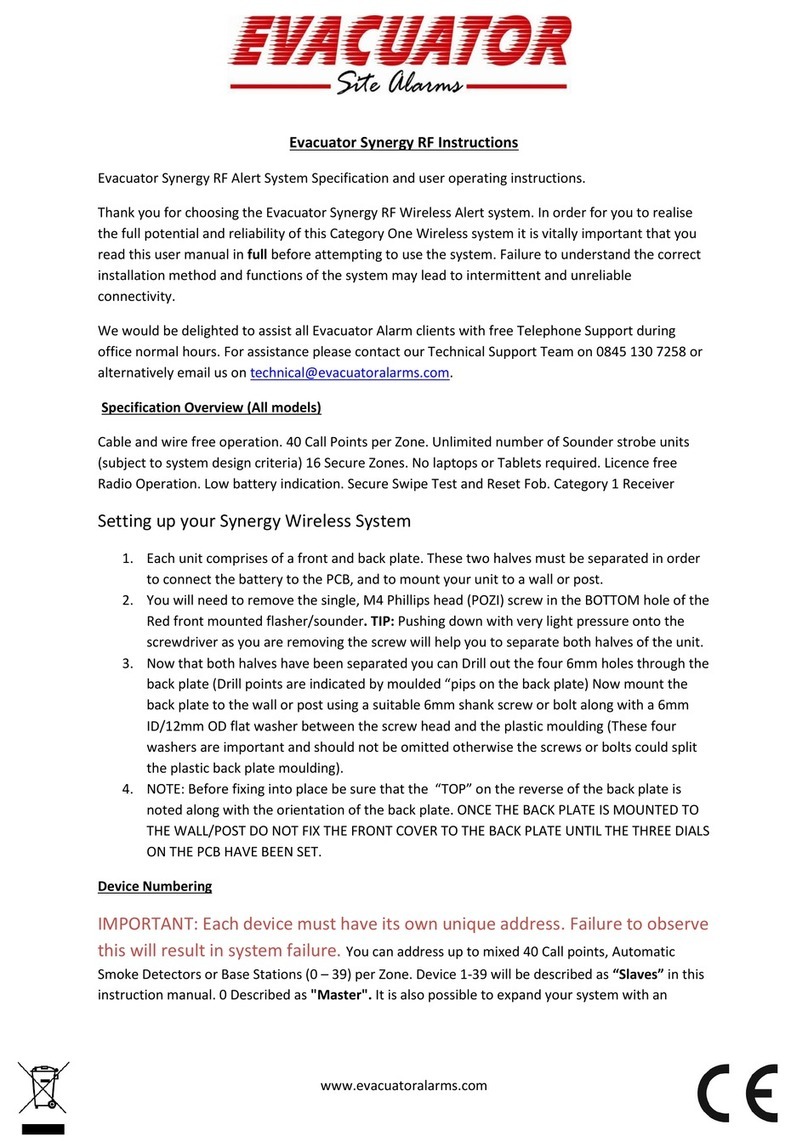
Evacuator
Evacuator Evacuator Synergy RF instructions
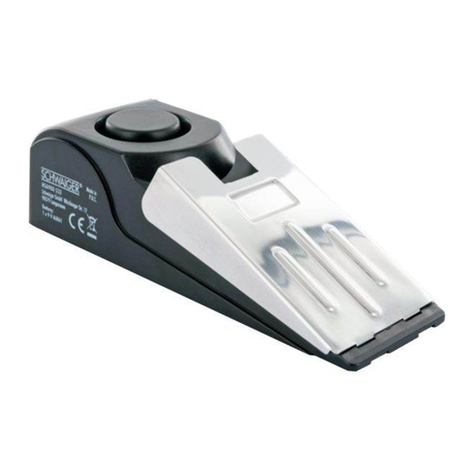
Schwaiger
Schwaiger SECURE 4 YOU HSA900 533 user manual
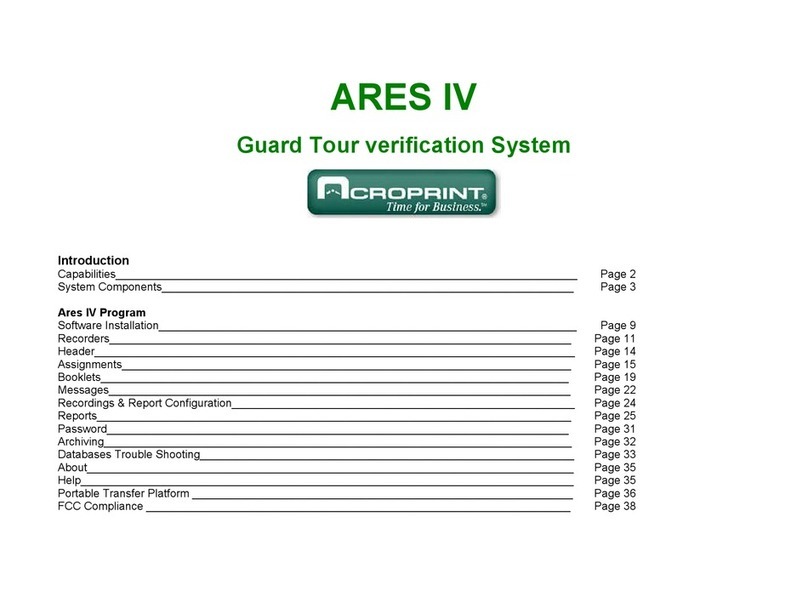
Acroprint
Acroprint ARES IV user manual

Magellan
Magellan Paradox MG-6160 Operation Operation & User’s Guide
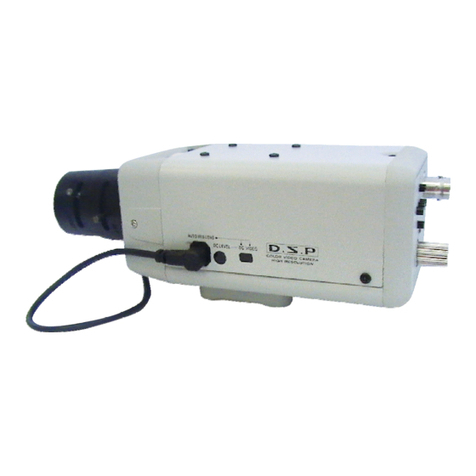
Monacor
Monacor TVCCD-623COL user manual

DEXAPLAN
DEXAPLAN GA 617 - B DU 11-2007 Important information
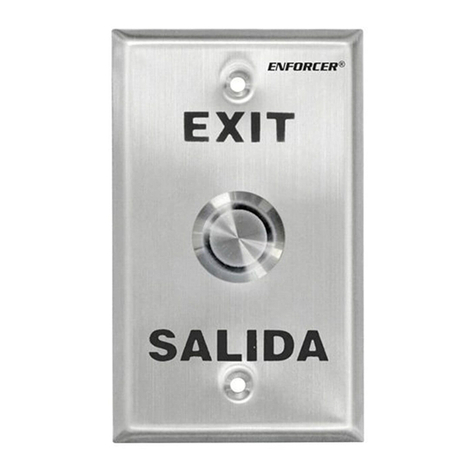
SECO-LARM
SECO-LARM SD-7104SGEX1Q installation manual
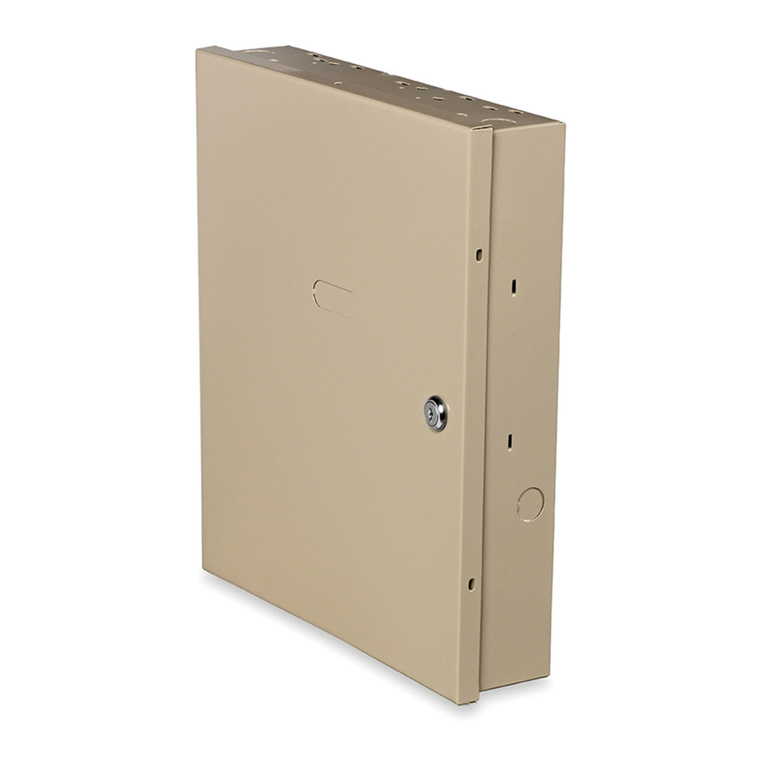
Honeywell
Honeywell Ademco VISTA-20P user guide

Aico
Aico RadioLink Ei208DWRF quick guide
